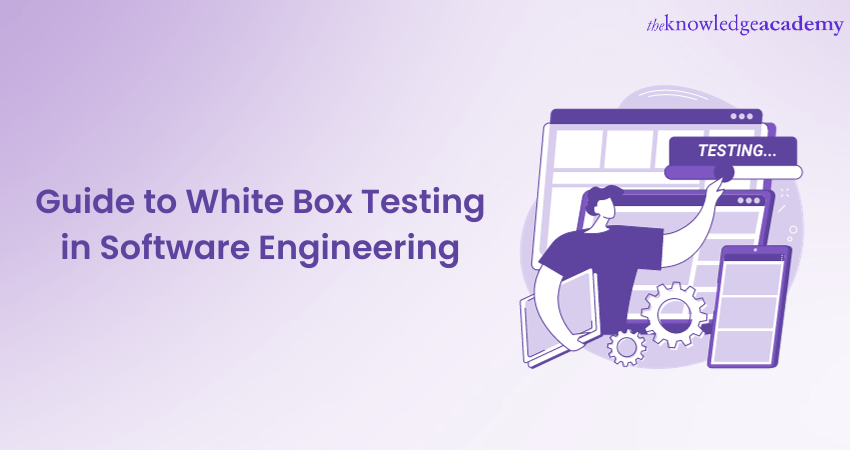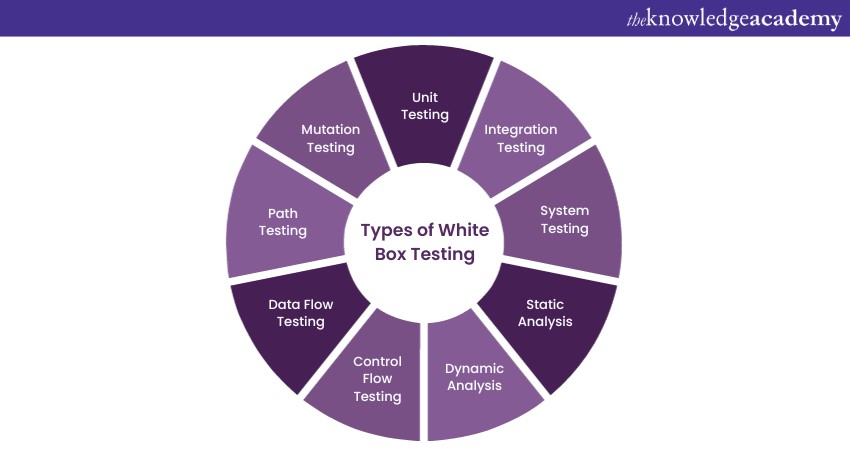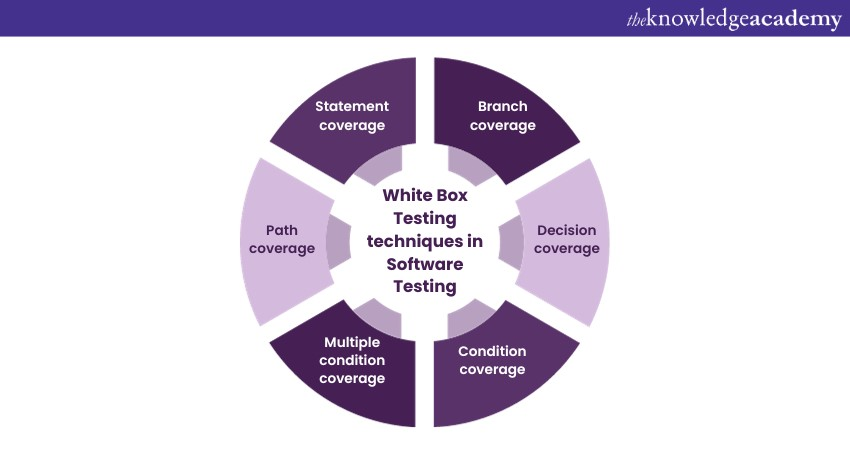We may not have the course you’re looking for. If you enquire or give us a call on +44 1344 203 999 and speak to our training experts, we may still be able to help with your training requirements.
Training Outcomes Within Your Budget!
We ensure quality, budget-alignment, and timely delivery by our expert instructors.

During the course of a Software Development Life Cycle (SDLC), Software Testing is one of the most complex and time-consuming processes. If the software is not tested thoroughly before being made available, it may crash unexpectedly, causing even more issues for the users. White Box Testing in Software Testing emerges as one of the most effective Testing methods to overcome this issue.
According to Glassdoor, the average salary for an amateur Software Tester in the UK is £37,365 per year. With such attractive salary packages, mastering the basics of White Box Testing can help you get started in the domain. So, read this blog to learn about what is White Box Testing in Software Testing. Also, explore how it can be performed and its advantages and disadvantages.
Table of Contents
1) What is White Box Testing in Software Testing?
2) Types of White Box Testing
3) Steps to perform White Box Testing
4) White Box Testing techniques used in Software Testing
5) Advantages and Disadvantages of White Box Testing
6) White Box Testing vs Black Box Testing
7) Conclusion
What is White Box Testing in Software Testing?
White Box Testing in Software Testing involves analysing the internal structures, data structures, internal designs, and codes instead of just Testing the code functionality. This is done to verify the input-output flow of the code, alongside improving the software’s design, security and usability. White Box Testing is often also known as Glass Box Testing or Clear Box Testing. The Tester has access to the source code and uses this knowledge to design test cases that can verify the correctness of the software at the code level. It is used to test the software's internal logic, flow, and structure. Moreover, it can be used to identify defects such as the following:
a) Incorrect or incomplete implementation of requirements
b) Inefficient code
c) Security vulnerabilities
d) Code that is difficult to maintain or extend
While being a powerful tool to ensure software quality, White Box Testing is notorious for being time-consuming and complex. It requires an in-depth knowledge of the software architecture and implementation.
Elevate your Software Testing skills with our comprehensive Software Testing Courses – join today and become a testing expert!
Why to perform White Box Testing in Software Testing?
Software Testers perform white Box Testing for the following reasons:
a) White Box Testing can help identify defects such as incorrect or incomplete implementation of requirements, inefficient code, security vulnerabilities, and code that is difficult to maintain or extend.
b) By finding and fixing defects early in the development process, White Box Testing can help to improve the overall quality and reliability of the software.
c) It can help to identify potential failure points in the software and reduce the risk of software failures occurring in production.
d) White Box Testing can help identify security vulnerabilities in the software and improve the overall security of the software.
e) By ensuring that the code is well-written and easy to understand, White Box Testing can help to increase the maintainability of the software.
Types of White Box Testing

There are many different types of White Box Testing, each with its own focus and benefits. Some of its most common types include the following:
a) Unit Testing: Unit Testing is a type of White Box Testing that focuses on testing individual units of code, such as functions or classes. It is often performed by Developers themselves as they write the code.
b) Integration Testing: Integration Testing focuses on testing how different units of code work together. Integration Testing is often performed after Unit Testing is complete.
c) System Testing: System Testing focuses on testing the entire software system as a whole. It is often performed after Integration Testing is complete.
d) Static Analysis: Static Analysis analyses the source code of the software without running it. This type of White Box Testing can be used to identify potential defects, such as syntax errors, security vulnerabilities, and inefficient code.
e) Dynamic Analysis: Dynamic Analysis focuses on analysing the software while it is running. Dynamic Analysis can be used to identify defects, such as logic errors, performance problems, and race conditions.
f) Control Flow Testing: Control Flow Testing is a type of White Box Testing that focuses on testing the flow of execution through the software's code.
g) Data Flow Testing: Data Flow Testing focuses on testing the flow of data through the software's code.
h) Path Testing: Path Testing is a type of White Box Testing that focuses on testing all of the possible paths of execution through the software's code.
i) Mutation Testing: Mutation Testing involves making small changes or mutations to the software's code and then testing to see if the software still works correctly.
Level up your testing skills and become a Software Testing Black Belt today for unmatched expertise with our Software Testing Black Belt Training - join now!
Steps to perform White Box Testing
The following steps are typically involved in performing White Box Testing in Software Testing:
a) Understanding the software's architecture and design: This includes understanding the different components of the software, how they interact with each other, and how the software's overall logic works.
b) Identifying the areas of the software that need to be tested: This can be done by analysing the software's requirements, design, and code.
c) Designing test cases: Test cases should be designed to cover all of the possible paths of execution through the software's code and to test all of the different scenarios that the software may encounter in production.
d) Executing the test cases: This can be done manually or using Automated Testing tools.
e) Analysing the test results: This involves identifying any defects that were found during testing and determining how to fix them.
f) Repeating steps 3-5 until all of the identified defects have been fixed.
Apart from the above-mentioned steps, the following tips will also aid in performing White Box Testing effectively:
a) Use a Test Case Management tool to track and manage your test cases.
b) Use Automated Testing tools to execute your test cases efficiently.
c) Use code coverage tools to ensure that you are covering all of the possible paths of execution through the software's code.
d) Involve Developers in the testing process. This can improve the quality of the test cases and ensure that defects are fixed quickly and efficiently.
Unlock your potential in Software Testing by joining our Software Testing Green Belt Course today!
White Box Testing techniques used in Software Testing
One of the primary White Box Testing methodologies is Code Coverage Analysis. It plays a vital role in ensuring the comprehensiveness of a test case suite by identifying areas of a program that remain untested. This Analysis detects portions of code that aren't exercised by the existing set of test cases.
When such gaps are pinpointed, it becomes necessary to create new test cases to validate the untested segments of the code. This process ultimately enhances the overall quality of the software product. Automated tools are readily available to facilitate Code Coverage Analysis. There exist several Coverage Analysis techniques that a White Box Tester can employ:

a) Statement Coverage: This technique aims to ensure that every statement or line of code in the application is executed at least once during Testing. It is a fundamental measure of code coverage.
b) Branch Coverage: Branch Coverage goes a step further by ensuring that all possible branches in the code, including if-else conditions and loops, are tested. It validates decision points in the code.
c) Decision Coverage: Decision Coverage, also known as Branch Condition Coverage, focuses on testing the true and false conditions within decision statements. It ensures that every possible decision outcome is evaluated.
d) Condition Coverage: It goes even deeper by examining the individual conditions within decision statements. It aims to test all possible combinations of conditions within complex conditions.
e) Multiple Condition Coverage: Also known as Modified Condition/Decision Coverage (MC/DC), this technique is commonly used in safety-critical systems. It ensures that each condition within a decision statement independently affects the outcome.
f) Path Coverage: Path Coverage is an exhaustive technique that tests every possible path or route through the code. It guarantees that all logical paths are exercised, providing comprehensive code coverage.
Unlock your potential in Software Testing and automation with Software Testing And Automation Training - join now!
Advantages and Disadvantages of White Box Testing
After learning everything about White Box Testing in Software Testing, it’s time to decide whether this Testing is useful or not. So, let’s take a look at the advantages and disadvantages of White Box Testing. Let's begin with the advantages, here’s a detailed breakdown:
a) Code optimisation by finding hidden errors: White Box Testing allows in-depth examination of the code, which helps uncover hidden errors and vulnerabilities. Identifying and rectifying these issues contributes to code optimisation and improves software reliability.
b) Ease of automation: White Box test cases are well-suited for automation. Automation tools can efficiently execute test scripts, making Regression Testing and continuous integration easier to manage.
c) Thorough Testing: White Box Testing ensures thorough coverage of code paths. By examining every branch, decision point, and condition, it provides a comprehensive assessment of the software's functionality and logic.
d) Early Testing in SDLC: White Box Testing can commence early in the Software SDLC, even before the Graphical User Interface (GUI) is fully developed. This early testing allows early detection and resolution of issues. This helps reduce development costs and cycle time.
Now, let’s explore the disadvantages of White Box Testing, which are as follows:
a) Complexity and cost: White Box Testing can be intricate and expensive. It requires specialised knowledge of the code's internal structure and thorough Testing techniques, which can increase project costs.
b) Developer aversion: Developers, who are often responsible for executing White Box test cases, may dislike this process. Their testing may lack the detail and impartiality that dedicated testers bring, potentially lea
c) Need for skilled resources: Effective White Box Testing demands resources with a deep understanding of programming and implementation. Employing or training such professionals can be a resource-intensive endeavour.
d) Time-consuming: White Box Testing can be time-consuming, particularly for larger and more complex applications. The need to examine every code path exhaustively may extend testing timelines, affecting project schedules.
White Box Testing vs Black Box Testing
White Box Testing and Black Box Testing are two distinct Software Testing methodologies in Software Engineering, each with its unique approach and objectives.
White Box Testing examines the internal structure, logic, and code of the software. Testers need an in-depth understanding of the application's architecture and algorithms to perform it effectively. Test cases in White Box Testing are designed based on the code's internal structure, focusing on aspects like Statement Coverage, Branch Coverage, and Path Coverage. The primary goal is to identify coding errors, security vulnerabilities, and optimise the code for better performance. White Box Testing in Software Testing can be executed at various stages of the Software Development Life Cycle and often involves Developers alongside dedicated Testers.
On the other hand, Black Box Testing assesses the software's functionality without knowledge of its internal workings. Testers treat the software as a "black box," concentrating on inputs, outputs, and user interactions. Knowledge of the code is not required, and test cases are derived from requirements, specifications, and user scenarios. The main objective of Black Box Testing is to validate whether the software meets functional and non-functional requirements, including usability and performance. It is typically conducted during the system testing and acceptance testing phases.
Implement and analyse methodologies in Testing by signing up for our ISTQB Software Testing Foundation Course now!
Conclusion
Hopefully, this blog informed you of the complexities and intricacies of White Box Testing in Software Testing. Despite being time-consuming and complex, it is the most complete and thorough methodology in Software Testing and mastering it will certainly help you advance your career as a Software Tester.
Verify software components individually by signing up for our Introduction to Unit Testing Course now!
Frequently Asked Questions
Upcoming Programming & DevOps Resources Batches & Dates
Date
 ISTQB Software Testing Foundation
ISTQB Software Testing Foundation
Mon 18th Nov 2024
Mon 2nd Dec 2024
Mon 16th Dec 2024
Mon 6th Jan 2025
Mon 3rd Feb 2025
Mon 17th Feb 2025
Mon 3rd Mar 2025
Mon 17th Mar 2025
Mon 31st Mar 2025
Mon 28th Apr 2025
Mon 19th May 2025
Mon 2nd Jun 2025
Mon 16th Jun 2025
Mon 30th Jun 2025
Mon 14th Jul 2025
Mon 28th Jul 2025
Mon 11th Aug 2025
Mon 8th Sep 2025
Mon 22nd Sep 2025
Mon 6th Oct 2025
Mon 20th Oct 2025
Mon 3rd Nov 2025
Mon 17th Nov 2025
Mon 1st Dec 2025
Mon 15th Dec 2025







 Top Rated Course
Top Rated Course



 If you wish to make any changes to your course, please
If you wish to make any changes to your course, please


